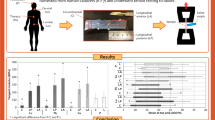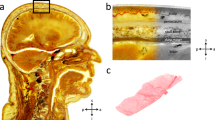Abstract
Knowledge of the mechanical behavior of spinal dura mater is important for a number of applications including the experimental and computational modeling of physiological phenomena and spinal cord trauma. However, mechanical characterization of dura mater is relatively sparse and is further compounded by the use of the tangent modulus as the sole measure of stiffness. This study aims to provide a more complete description of the mechanical properties of spinal dura mater, including the effect of strain rate. Bovine dura mater was tested under uniaxial tension in both the longitudinal and the circumferential directions at three different strain rates; 0.01, 0.1, and 1.0 s−1. An Ogden model was fitted to the resulting stress–stretch data. The morphology of the dura mater was assessed using Sirius red and H&E staining. No significant effect of the strain rate was found for the Ogden model parameters. Longitudinal specimens were significantly stronger and more deformable than circumferential samples, probably due to the structural arrangement of the collagen fibers. At low strains, however, the circumferential specimens were stiffer than the longitudinal ones. The findings of this study will allow more complete representations of the spinal dura mater to be developed.












Similar content being viewed by others
References
Atlas, S. W., V. Regenbogen, L. F. Rogers, and K. S. Kim. The radiographic characterization of burst fractures of the spine. AJR Am. J. Roentgenol. 147:575–582, 1986.
Bilston, L. E., and L. E. Thibault. The mechanical properties of the human cervical spinal cord in vitro. Ann. Biomed. Eng. 24:67–74, 1996.
Crisco, J. J., D. C. Moore, and R. D. McGovern. Strain-rate sensitivity of the rabbit MCL diminishes at traumatic loading rates. J. Biomech. 35:1379–1385, 2002.
Elliott, D. M., D. A. Narmoneva, and L. A. Setton. Direct measurement of the Poisson’s ratio of human patella cartilage in tension. J. Biomech. Eng. 124:223–228, 2002.
Fiford, R. J., and L. E. Bilston. The mechanical properties of rat spinal cord in vitro. J. Biomech. 38:1509–1515, 2005.
Hall, R. M., R. J. Oakland, R. K. Wilcox, and D. C. Barton. Spinal cord-fragment interactions following burst fracture: an in vitro model. J. Neurosurg. Spine 5:243–250, 2006.
Hewitt, J., F. Guilak, R. Glisson, and T. P. Vail. Regional material properties of the human hip joint capsule ligaments. J. Orthop. Res. 19:359–364, 2001.
Ichihara, K., T. Taguchi, I. Sakuramoto, S. Kawano, and S. Kawai. Mechanism of the spinal cord injury and the cervical spondylotic myelopathy: new approach based on the mechanical features of the spinal cord white and gray matter. J. Neurosurg. 99:278–285, 2003.
Loth, F., M. A. Yardimci, and N. Alperin. Hydrodynamic modeling of cerebrospinal fluid motion within the spinal cavity. J. Biomech. Eng. 123:71–79, 2001.
Maikos, J. T., R. A. Elias, and D. I. Shreiber. Mechanical properties of dura mater from the rat brain and spinal cord. J. Neurotrauma 25:38–51, 2008.
Mazuchowski, E. L., and L. E. Thibault (2003). Biomechanical properties of the human spinal cord and pia mater. Summer Bioengineering Conference. Sonesta Beach Resort in Key Biscayne, FL, USA.
Ogden, R. W. Large deformation isotropic elasticity—on the correlation of theory and experiment for incompressible rubberlike solids. Proc. R. Soc. Lond. Ser. A Math. Phys. Sci. 326:565–584, 1972.
Patin, D. J., E. C. Eckstein, K. Harum, and V. S. Pallares. Anatomic and biomechanical properties of human lumbar dura mater. Anesth. Analg. 76:535–540, 1993.
Reid, J. D. Effects of flexion-extension movements of the head and spine upon the spinal cord and nerve roots. J. Neurol. Neurosurg. Psychiatry 23:214–221, 1960.
Runza, M., R. Pietrabissa, S. Mantero, A. Albani, V. Quaglini, and R. Contro. Lumbar dura mater biomechanics: experimental characterization and scanning electron microscopy observations. Anesth. Analg. 88:1317–1321, 1999.
Tencer, A. F., B. L. Allen, Jr., and R. L. Ferguson. A biomechanical study of thoracolumbar spine fractures with bone in the canal. Part III. Mechanical properties of the dura and its tethering ligaments. Spine 10:741–747, 1985.
Ting, T. C. T., and T. Chen. Poisson’s ratio for anisotropic elastic materials can have no bounds. Q. J. Mech. Appl. Math. 58:73–82, 2005.
Tunituri, A. R. Elasticity of the spinal cord dura in the dog. J. Neurosurg. 47:391–396, 1977.
Wilcox, R. K., D. J. Allen, R. M. Hall, D. Limb, D. C. Barton, and R. A. Dickson. A dynamic investigation of the burst fracture process using a combined experimental and finite element approach. Eur. Spine J. 13:481–488, 2004.
Wilcox, R. K., L. E. Bilston, D. C. Barton, and R. M. Hall. Mathematical model for the viscoelastic properties of dura mater. J. Orthop. Sci. 8:432–434, 2003.
Woo, S. L., M. A. Gomez, and W. H. Akeson. The time and history-dependent viscoelastic properties of the canine medical collateral ligament. J. Biomech. Eng. 103:293–298, 1981.
Yuan, Q., L. Dougherty, and S. S. Margulies. In vivo human cervical spinal cord deformation and displacement in flexion. Spine 23:1677–1683, 1998.
Acknowledgment
This study was financially supported by the European Community, Contract MEST-CT-2005-020599.
Author information
Authors and Affiliations
Corresponding author
Additional information
Associate Editor Sean S. Kohles oversaw the review of this article.
Rights and permissions
About this article
Cite this article
Persson, C., Evans, S., Marsh, R. et al. Poisson’s Ratio and Strain Rate Dependency of the Constitutive Behavior of Spinal Dura Mater. Ann Biomed Eng 38, 975–983 (2010). https://doi.org/10.1007/s10439-010-9924-6
Received:
Accepted:
Published:
Issue Date:
DOI: https://doi.org/10.1007/s10439-010-9924-6




